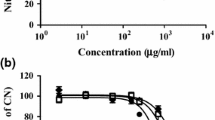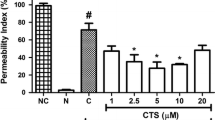Abstract
Background
Expression of cell adhesion molecules (CAM) on the endothelium and the attachment of monocytes to endothelium may play a major role in the early atherogenic process. Chlorogenic acid is a phenolic compound present in coffee, apples, pears, berries, almonds, artichokes, and aubergines. Previous studies have indicated that CA possesses antioxidant activity in vitro.
Aim
We investigated the effects of chlorogenic acid and probucol on monocyte-like adhesion, adhesion molecule expression, NF-κB translocation and ROS production in IL-1β-induced human umbilical vein endothelial cells (HUVECs).
Results
According to the results of the MTT assay, we chose 25 and 50 μmol/L to perform the experiments. Chlorogenic acid dose-dependently suppressed IL-1β-induced mRNA expression of vascular cell adhesion molecule-1, intercellular cell adhesion molecule-1 and endothelial cell selectin. Chlorogenic acid also suppressed the IL-1β-induced production of ROS. We also observed that chlorogenic acid attenuated or blocked IL-1β-induced nuclear translocation of nuclear factor-κB subunits p50 and p65, which in turn attenuated CAM expression at the transcription level. Furthermore, chlorogenic acid significantly reduced the adhesion of human monocyte cells (U937) to IL-1β-treated HUVECs in a dose–response manner. These results are similar to that of probucol.
Conclusions
We conclude that chlorogenic acid exhibit anti-inflammatory effects in HUVECs by inhibition of U937 monocyte-like adhesion, adhesion molecule expression, NF-κB translocation, and ROS production. The anti-inflammatory activity of chlorogenic acid in HUVECs suggests that chlorogenic acid could be useful in the prevention of atherosclerosis.






Similar content being viewed by others
References
Baeuerle PA, Henkel T (1994) Function and activation of NF-κB in the immune system. Ann Rev Immunol 12:141–179
Barnes PJ, Karin M (1997) Nuclear factor-kappa B: a pivotal transcription factor in chronic inflammatory diseases. N Engl J Med 336:1066–1071
Bass DA, Parce JW, Dechatelet LR, Szejda P, Seeds MC, Thomas M (1983) Flow cytometric studies of oxidative product formation by neutrophils: a graded response to membrane stimulation. J Immunol 130:1910–1917
Carew TE, Schwenke DC, Steinberg D (1987) Antiatherogenic effect of probucol unrelated to its hypocholesterolemic effect: evidence that antioxidants in vivo can selectively inhibit low density lipoprotein degradation in macrophage rich fatty streaks and slow the progression of atherosclerosis in Watanabe heritable hyperlipidemic rabbit, an animal model for familial hypercholesterolemia. Proc Natl Acad Sci USA 84:5925–5931
Carluccio MA, Siculella L, Ancora MA, Massaro M, Scoditti E, Storelli C, Visioli F, Distante A, Caterina RD (2003) Olive oil and red wine antioxidant polyphenols inhibit endothelial activation. Antiatherogenic properties of mediterranean diet phytochemicals. Arterioscler Thromb Vasc Biol 23:622–629
Chen YH, Lin SJ, Chen JW, Ku HH, Chen YL (2002) Magnolol attenuates VCAM-1 expression in vitro in TNF-α-treated human aortic endothelial cells and in vivo in the aorta of cholesterol-fed rabbits. Br J Pharmacol 135:37–47
Chenbg Q, Cant CA, Moll T, Hofer-Warbinek R, Wagner E, Birnstiel ML, Bach FH, de Martin R (1994) NF-κB subunit-specific regulation of the I kappa B-alpha promoter. J Biol Chem 296:13551–13557
Collins T (1993) Biology of disease: endothelial nuclear factor-κB and the initiation of the atherosclerotic lesion. Lab Invest 68:499–508
Cybulsky MI, Gimbrone MA Jr (1991) Endothelial expression of a mononuclear leukocyte adhesion molecule during atherogenesis. Science 251:788–791
Dschietzig T, Richter C, Pfannenschmidt G, Bartsch C, Laule M, Baumann G, Stangl K (2001) Dexamethasone inhibits stimulation of pulmonary endothelins by proinflammatory cytokines: possible involvement of a nuclear factor κB dependent mechanism. Intensive Care Med 27:751–756
Gaziano JM, Manson J, Buring JE, Hennekens CH (1992) Dietary antioxidants and cardiovascular disease. Ann NY Acad Sci 669:249–259
Gey KF, Stahelin HB, Eichholser M (1993) Poor plasma status of carotene and vitamin C is associated with higher mortality from ischemic heart disease and stroke: Panel Prospective Study. J Clin Invest 71:3–6
Ghosh G, van Duyne G, Ghosh S, Sigler PB (1995) Structure of NF-κB p50 homodimer bound to a κB site. Nature 373:303–310
Inouye M, Hashimoto H, Abo K, Tsuzuki D, Mio T, Sumino K (1998) The effect of probucol on oxidized cholesterol disposition in hyperlipidemic patients. J Int Med Res 26:233–238
Islam KN, Devaraj S, Jialal I (1998) alpha-Tocopherol enrichment of monocytes decrease agonist-induced adhesion to human endothelial cells. Circulation 98:2255–2261
Joris I, Zand T, Nunnari JJ, Krolikowski FJ, Majno G (1983) Studies on the pathogenesis of atherosclerosis. I: adhesion and emigration of mononuclear cells in the aorta of hypercholesterolemic rats. Am J Pathol 113:341–358
Kasai H, Fukada S, Yamaizumi Z, Sugie S, Mori H (2000) Action of chlorogenic acid in vegetables and fruit as an inhibitor of 8-hydroxydeocyguanosine formation in vitro and in a rat carcinogenesis model. Food Chem Toxicol 38:467–471
Keaney JF Jr, Xu A, Cunningham D, Jackson T, Frei B, Vita JA (1995) Dietary probucol preserves endothelial function in cholesterol-fed rabbits by limiting vascular oxidative stress and superoxide generation. J Clin Invest 95:2520–2529
Kweon MH, Hwang HJ, Sung HC (2001) Identification and antioxidant activity of novel chlorogenic acid derivatives from bamboo (Phyllostachys edulis). J Agric Food Chem 49:4646–4655
Li LX, Chen JX, Liao DF, Yu L (1998) Probucol inhibits oxidized-low density lipoprotein-induced adhesion of monocytes to endothelial cells by reducing P-selectin synthesis in vitro. Endothelium 6:1–8
Li X, Wang X (2002) Application of real-time polymerase chain reaction for the quantitation of interleukin-1β mRNA upregulation in brain ischemic tolerance. Brain Res Protocol 5:211–217
Ludwig A, Lorenz M, Grimbo N, Steinle F, Meiners S, Bartsch C, Stangl K, Baumann G, Stangl V (2004) The tea flavonoid epigallocatechin-3-gallate reduces cytokine-induced VCAM-1 expression and monocyte adhesion to endothelial cells. Biochem Biophys Res Commun 316:659–665
Mackness MI, Durringtom PN (1992) Lipoprotein separation & analysis for clinical studies. In: Converse CA, Skinner ER (eds) Lipoprotein analysis: a practical approach. IRL Press, Oxford, pp 1–42
Martin A, Foxall T, Blumberg JB, Meydani M (1997) Vitamin E inhibits low density lipoprotein-induced adhesion of nomocyutes to human aoric endothelial cells in vitro. Arterioscl Thromb Vasc biol 17:429–436
Muller JM, Rupec RA, Baeuerle PA (1997) Study of gene regulation by NF-kappa B and AP-1 in response to reactive oxygen intermediates. Methods 11:301–312
Nakatani N, Kayano SI, Kikuzaki H, Sumino K, Katagiri K, Takahiko M (2000) Identification, quantitative determination, and antioxidative activities of chlorogenic acid isomers in prune (Prunus domestica L. I.). J Agric Food Chem 48:5512–5516
O’Brien KD, Allen MD, McDonald TO, Chait A, Harlan JM, Fishbein D, McCarty J, Ferguson M, Hudkins K, Benjamin CD, Lobb R, Alpers CE (1993) Vascular cell adhesion molecule-1 is expressed in human coronary atherosclerotic plaque: implications for the mode of progression of advanced coronary atherosclerosis. J Clin Invest 92:945–951
Olthof MR, Hollman PC, Katan MB (2001) Chlorogenic acid and caffeic acid are absorbed in humans. J Nutr 131:66–71
Olthof MR, Hollman PC, Katan MB (2001) Consumption of high does of chlorogenic acid, present in coffee, or of black tea increases plasma total homocysteine concentration in humans. Am J Clin Nutr 73:532–538
Olthof MR, Hollman PC, Buijsman MN, van Amelsvoort JM, Katan MB (2003) Chlorogenic acid, quercetin-3-rutinoside and black tea phenols are extensively metabolized in humans. J Nutr 133:1806–1814
Qwarnstrom EE, Ostberg CO, Turk GL, Richardson CA, Bomsztyk K (1994) Fibronectin attachment activates the NF-κB p50/p65 heterodimer in fibroblasts and smooth muscle cells. J Biol Chem 269:30765–30768
Rodriguez de Sotillo D, Hadley M (2002) Chlorogenic acid modifies plasma and liver concentrations of cholesterol, triacylglycerol, and minerals in (fa/fa) Zucker rats. J Nutr Biochem 13:717–726
Ross R (1992) Atherosclerosis is an inflammatory disease. Am Heart J 138:S419–S420
Takemura T, Sakai M, Matsuda H, Matsumura T, Biwa T, Anami Y (2000) Effects of probucol on cholesterol metabolism in mouse peritoneal macrophages: inhibition of HDL-medicated cholesterol efflux. Atherosclerosis 152:347–357
van der Wal AC, Das PK, Tigges AJ, Becker AE (1992) Adhesion molecules on the endothelium and mononuclear cells in human atherosclerotic lesions. Am J Pathol 141:1427–1433
Wallin B, Rosengren B, Shertzer HG, Camejo G (1993) Lipoprotein oxidation and measurement of thiobarbituric acid reacting substances formation in a single microtiter plate: its use for evalution of antioxidants. Anal Biochem 208:10–15
Yamaguchi T, Takamura H, Matoba T, Terao J (1998) HPLC method for evaluation of the free radical-scavenging activity of foods by using 1, 1-dipheny-2-picrylhydrazyl. Biosci Biotechnol Biochem 62:1201–1204
Zapolska-Downar D, Zapolski-Downar A, Markiewski M, Ciechano-wicz A, Kaczmarczyk M, Naruszewicz M (2001) Selective inhibition by probucol of vascular cell adhesion molecule-1 (VCAM-1) expression in human vascular endothelial cells. Atherosclerosis 155:123–130
Zhou Z, Liu Y, Miao AD, Wang SQ (2005) Protocatechuic aldehyde suppresses TNF-α-induced ICAM-1 and VCAM-1 expression in human umbilical vein endothelial cells. Eur J Pharmacol 513:1–8
Author information
Authors and Affiliations
Corresponding author
Rights and permissions
About this article
Cite this article
Chang, WC., Chen, CH., Lee, MF. et al. Chlorogenic acid attenuates adhesion molecules upregulation in IL-1β-treated endothelial cells. Eur J Nutr 49, 267–275 (2010). https://doi.org/10.1007/s00394-009-0083-1
Received:
Accepted:
Published:
Issue Date:
DOI: https://doi.org/10.1007/s00394-009-0083-1




